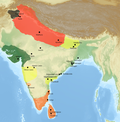Sthavira nikāya (redirect from Sthaviravadins) The Sthavira nikāya (Sanskrit "Sect of the Elders"; Chinese: 上座部; pinyin: Shàngzuò Bù) was one of the early Buddhist schools. They split from the majority... 8 KB (918 words) - 12:25, 14 March 2024 |
the Mahāsāṃghikas used Prakrit, the Sarvāstivādins used Sanskrit, the Sthaviravādins used Paiśācī, and the Saṃmitīya used Apabhraṃśa. This observation has... 91 KB (10,484 words) - 16:18, 24 April 2024 |
Shishunaga dynasty and held in Vaishali. The Sangha divides into the Sthaviravadins and the Mahasanghikas led by the monk Mahādeva, primarily over the question... 54 KB (972 words) - 16:40, 20 February 2024 |
the Mahāsāṃghikas used Prākrit, the Sarvāstivādins used Sanskrit, the Sthaviravādins used Paiśācī, and the Saṃmitīya used Apabhraṃśa. The most widely known... 6 KB (657 words) - 14:02, 6 January 2024 |
that the Mahāsāṃghikas used Prākrit, the Sarvāstivādins Sanskrit, the Sthaviravādins used Paiśācī and the Saṃmitīya used Apabhraṃśa. An important source... 61 KB (7,658 words) - 23:49, 21 April 2024 |
 | prominence in the Pāli texts is indicative of the preference of the Sthaviravādins for vinaya above discourse, whereas the prominence of Ānanda in the... 38 KB (4,354 words) - 02:19, 8 September 2023 |


